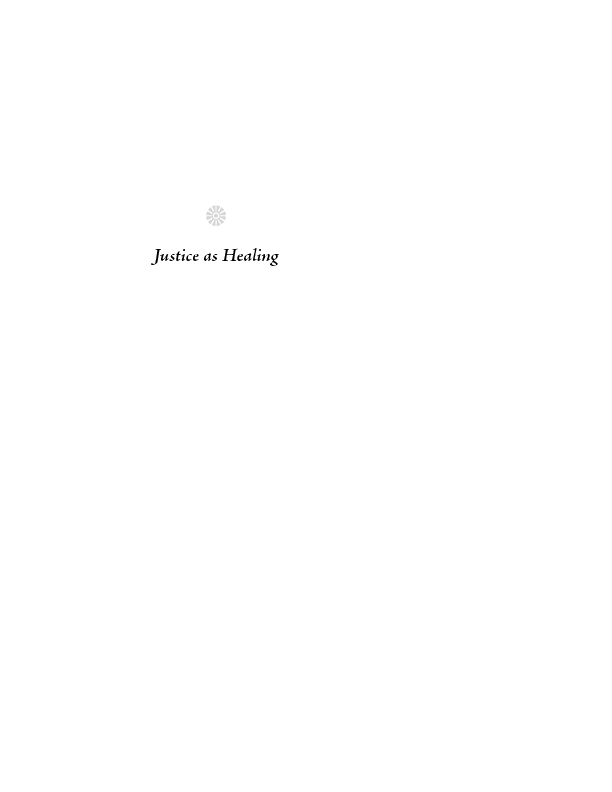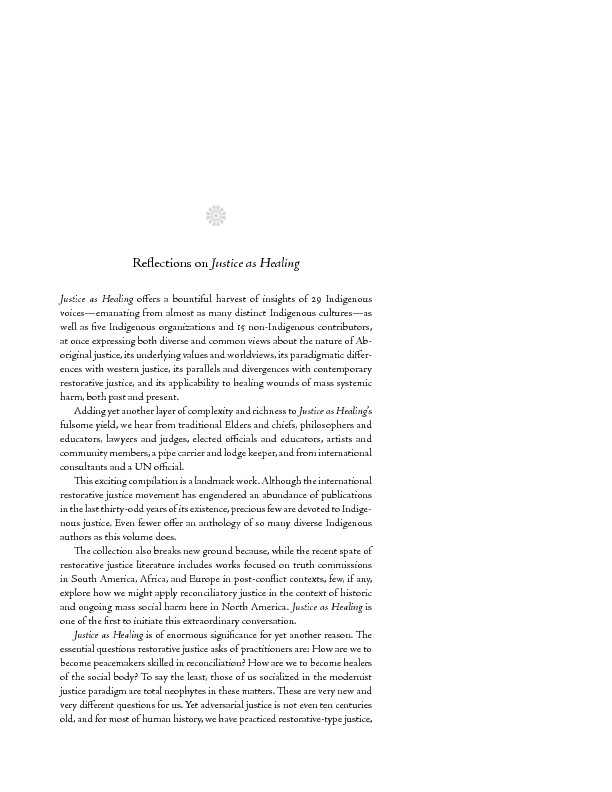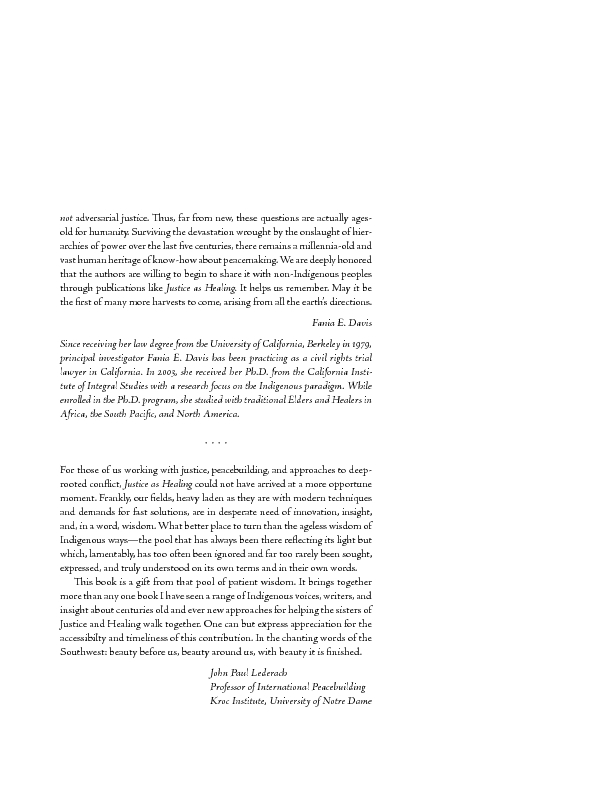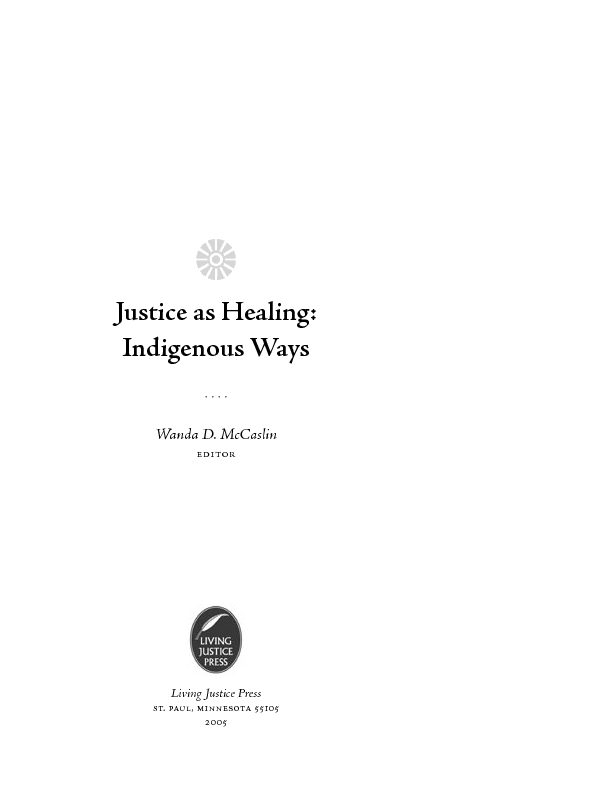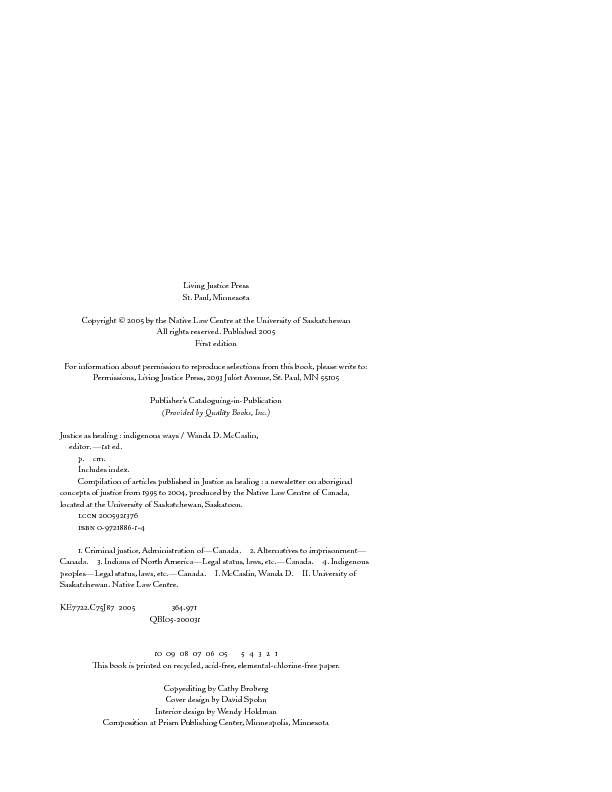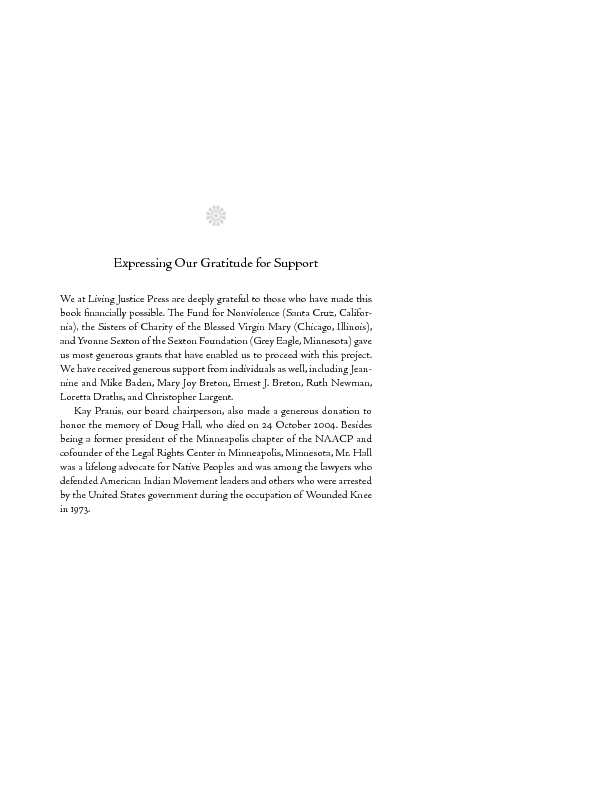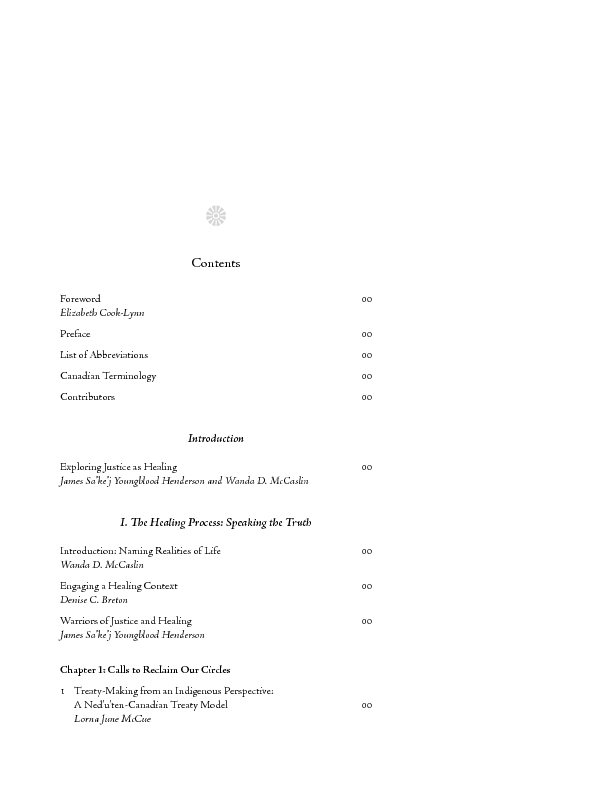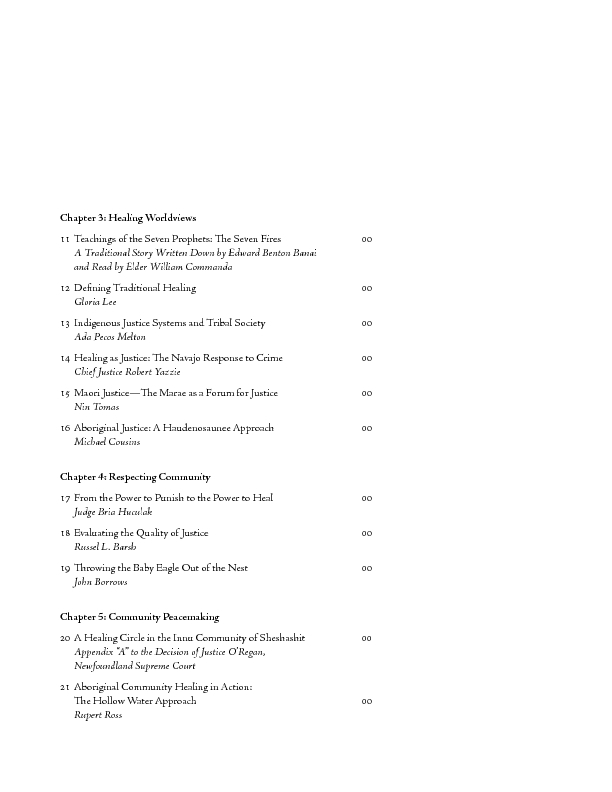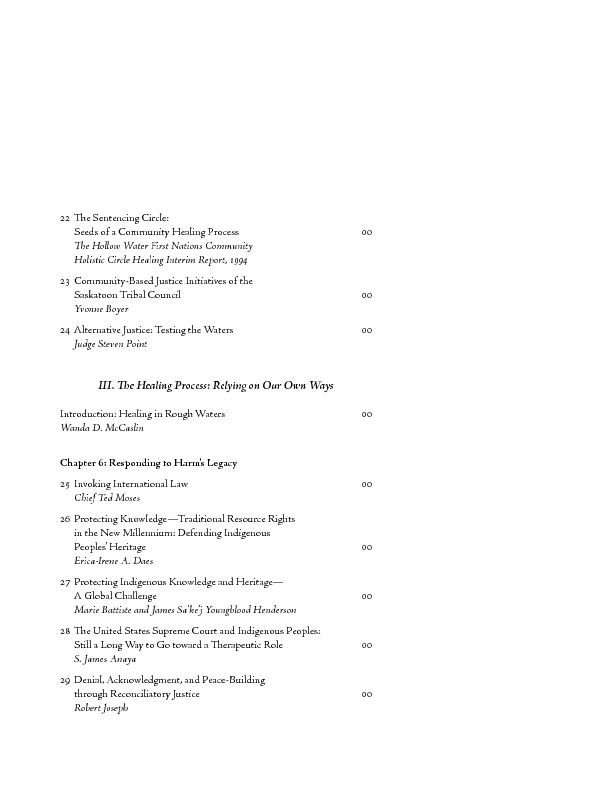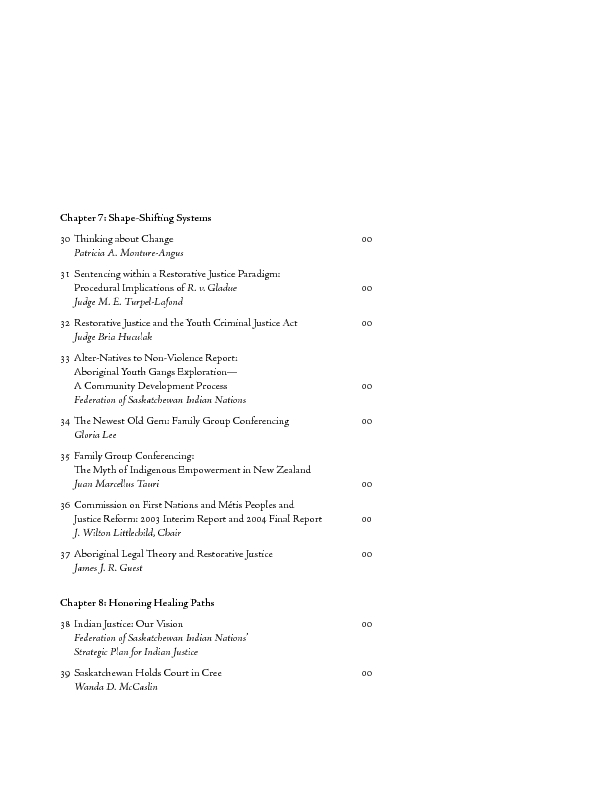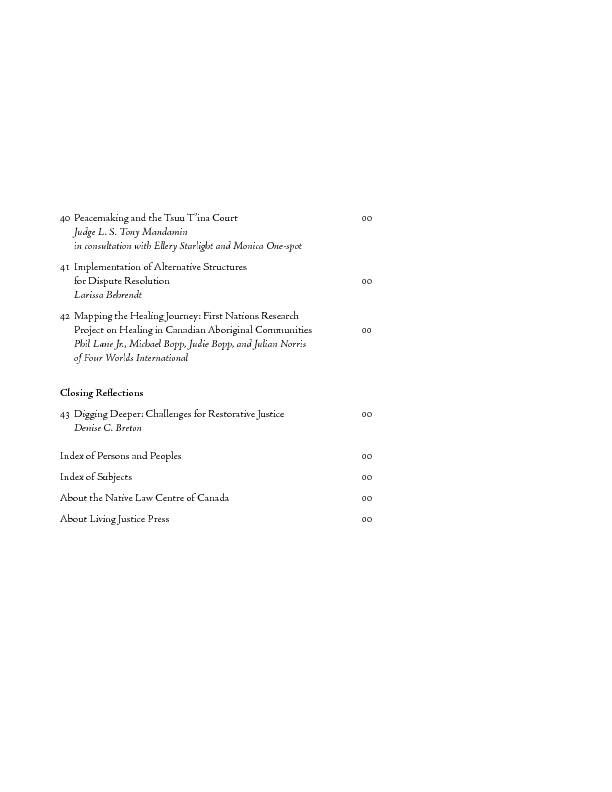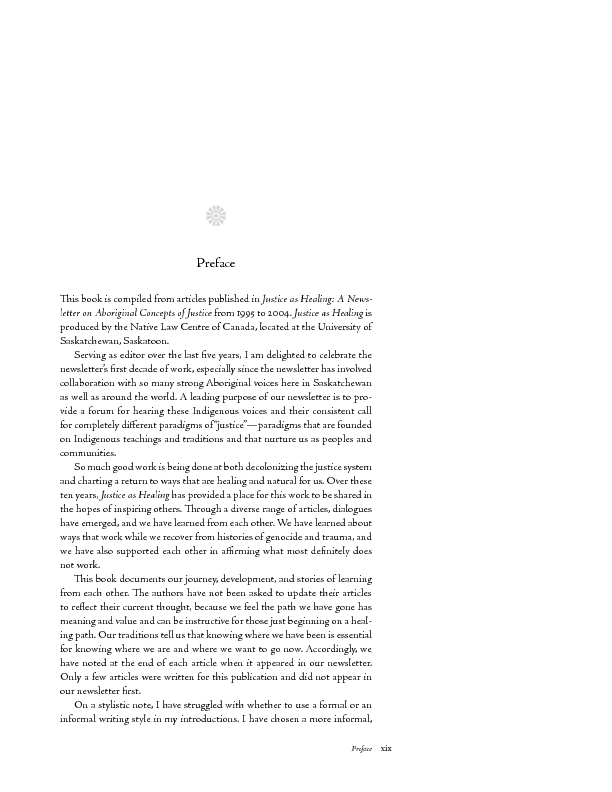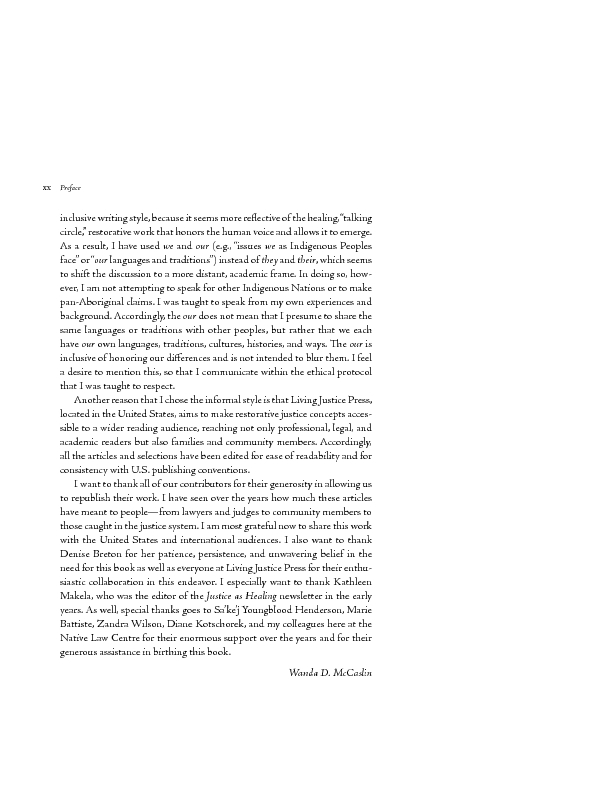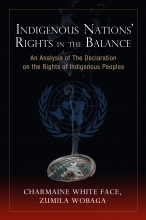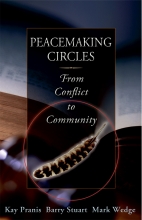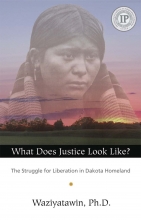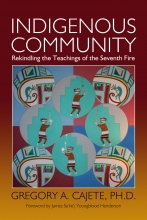Justice As Healing
*****IF YOU WISH TO ORDER HARD COPIES OF OUR BOOKS, PLEASE VISIT https://livingjusticepress.org*****
Justice As Healing
By: Wanda D. McCaslin
Drawing on a decade of writing on justice and community-based responses to conflicts, this substantive book features 45 articles from community members, scholars, judges, lawyers, and Elders. Justice As Healing is now the main textbook in countless classes on Indigenous Studies as well as on restorative justice.
Title information
Restorative justice traces its roots to Indigenous traditions world-wide, yet no book on justice presents Indigenous voices speaking directly about Indigenous ways of responding to harms and restoring harmony in relationships. Justice As Healing does just that. It is a collection of articles from the Justice As Healing newsletter produced by the Native Law Centre of Canada at the University of Saskatchewan. Drawing on a decade of writing on justice and on community-based, healing responses to conflicts and crimes, this substantive book features forty-five articles from community members, scholars, judges, lawyers, and Elders, most of whom are Indigenous.
Wanda D. McCaslin
Wanda D. McCaslin, a Métis woman from northern Saskatchewan, obtained her B.A. in political science and her LL.B. from the University of Saskatchewan in 1996. She is currently a Master of Laws candidate examining the sentencing provisions of hate-motivated crimes. The working title of her thesis is: "Remedying hate motivated offences toward Aboriginal Peoples: the Prairie Provinces and judicial decision-making through the sentencing provisions of s. 718.2(a)(i)". She is an academic, author, sessional lecturer of the academic support program at the College of Law, and legal researcher working as the Saskatchewan Law Foundation Research Officer at the Native Law Centre, College of Law, University of Saskatchewan. Throughout her career, issues of hatred, justice and security, healing, restoration and collaboration have been central to her work. She has received awards and recognition for her work on a variety of Aboriginal initiatives and has recently completed research projects on identity, membership and kinship; duty to consult and accommodate; First Nation communities at risk or in crisis; and other projects specific to the quality of life for Aboriginal women in Canada.

Praise for Justice As Healing
Elizabeth Cook-Lynn
Eminent Native scholar, poet, and activist; author of Anti-Indianism in Modern America: A Voice from Tatekeya's Earth; enrolled member, Crow Creek Sioux Tribe, Fort Thompson, SD
Well conceived and brilliantly written by people who know what they are talking about, Justice As Healing shows us that our responsibilities are not about control and supremacy but, rather, about how to value our lives and make them whole. This book is critical reading for the whole world of activists and scholars who are worried about the outcomes of brutal colonization or past centuries and want to act on their own most fundamental right to determine their own destinies.
Fania E. Davis
Civil rights trial lawyer and director of Restorative Justice for Oakland Youth (RJOY)
This exciting compilation is a landmark work . . . While the recent spate of restorative justice literature includes works focused on truth commissions in South America, Africa, and Europe in post-conflict contexts, few, if any, explore how we might apply reconciliatory justice in the context of historic and ongoing mass social harm here in North America. Justice As Healing is one of the first to initiate this extraordinary conversation.
Howard Zehr
Co-director, Conflict Transformation Program, Eastern Mennonite University, and author of Changing Lenses: A New Focus for Crime and Justice and The Little Book of Restorative Justice.
For too long, restorative justice has been primarily articulated and interpreted by Anglos (like me). For too long, Indigenous understandings of justice have been interpreted by outsiders. For far too long the justice discourse has been dominated by the majority culture. Justice as Healing begins to right the balance through a chorus of voices from within Indigenous communities in North America and New Zealand: eloquent voices that, despite their diversity, present a remarkable coherence.
Tribal College Journal, Fall 2006
Reviewed by Michael Thompson
This unique collection is subtitled "Writings on Community Peacemaking and Restorative Justice from the Native Law Center," located at the University of Saskatchewan. The articles, primarily by indigenous voices, were originally published in the law center's newsletter, 1995-2004. The contributors include traditional elders, educators, lawyers, judges, elected officials, community activists and international consultants.
Most address the aboriginal concepts of "restorative justice" or "justice as healing," which is seen generally in opposition to Eurocentric notions of justice involving punishment, deterrence, retribution, and violence. Many writers recount attempts by Native communities to indigenize the judicial process, especially with "healing circles" and similar alternatives.
Issues addressed include addiction and gangs as well as domestic violence. In her foreword, Elizabeth Cook-Lynn says this book "shows us that our responsibilities are not about control and supremacy but, rather, how to value our lives and make them whole.”
This book is recommended for a tribal college library.
Cultural Survival Quarterly, Summer 2006
Reviewed by Gloria Bletter
This book of selections about indigenous, mostly North American, ways of justice is overdue. It can usefully serve as a reference and guide to how Native North Americans dealt with discord in their own pre-colonial societies, and to their varied responses to European-based law; it also provides guidelines for those seeking change in existing legal systems. To illustrate, the editor notes that the articles about healing and sentencing circle procedures in indigenous communities (Innu, Navajo, Maori, and Haudenosaunee, among others), have been among the most requested reprints from the original newsletter (also entitled “Justice as Healing”), upon which this book is based. The newsletter articles were published between 1995 and 2004 by the Native Law Centre of Canada, located at the University of Saskatchewan.
Justice as Healing has been made accessible to non-Native and non-Canadian readers: it contains a list of abbreviations and of Canadian terms; each of the major three sections has its own introduction; and it includes a full description of contributors’ backgrounds, including organizational contributors (such as Federations and Healing Circles).
The description of traditional justice will appeal to those who find current legal systems inadequate, as well as to those who would like to see increasing attention paid to the ‘local’--the community--as an antidote to impersonal forces which seem to determine our lives from afar. To the extent that we feel helpless to change our political institutions, we are also ‘colonized.’ The contributors to this book seek change in the long term: “When we begin to formulate a view of our true identity, we are inevitably forced to understand our past oppression as well as to decolonize the criminal justice system.” [Introduction] This can be a painful process, but the indigenous emphasis on relatedness and community will support the individual’s quest to heal. Traditional ways are varied, but all are rooted in a holistic perspective, and concepts of “justice” include reconciling both the natural world and that of emotions--the entire universe. The Maori author says “Justice is the means by which we, as humans, keep our world balanced.” Because relatedness and relationships are so important in indigenous societies, law, as life, is linked to the elaborate relationships which still exist in many tribal communities. Under indigenous peacemaking, also known as restorative justice, “offenders remain an integral part of the community because of their important role in defining the boundaries of appropriate and inappropriate behavior...” [Melton, p.109] These notions are different than a system in which ‘bad’ behavior is defined in detailed written codes, and in which the offender is sent away from the community in which the offense ocurred. The person harmed is also recognized as being a member of an injured family and community, each of which has to be put back into balance, to be made whole. While the means to restoration differ among various indigenous societies, this basic outlook remains.
Healing requires confronting internalized trauma over generations, pressures to assimilate, and the ongoing denigration of peoples and cultures. “Because we have internalized many of these destructive patterns, harms make us confront how we are acting them out--not on the colonizers but in most cases on each other.” [Introduction, Sec.II, p.89] The challenge involves bringing the community back into the picture, which then finds its own way back to harmony. There is much agreement among the authors here that successful justice projects must be firmly rooted in the communities they are intended to serve, and cannot be imposed from above. A non-Native chief judge from Alberta so stated: “There is no one model of justice development. This must be kept in mind while the communities and the urban centers are developing the processes that best address their own needs.” [Boyer, p. 205]
Changing criminal justice systems requires initiating entirely new respectful listening processes, both among and within Native groups, and between them and members of existing legal structures. Since norms as to what constitutes wrongs are often essentially the same, e.g., theft, assault causing injury, and sexual abuse [Green and Healy, p. 62], similar ‘legal’ standards regarding breaches in interpersonal relations (criminal and family matters) could be adopted.
What is much more difficult is instituting and adjusting socio-economic institutional arrangements in response to abuses and oppression by the dominant state. Restoration via financial compensation will not work in indigenous communities, especially for loss of land.
One contributor to this volume, Erica-Irene A. Daes, a human rights official from the UN and preparer of its “Principles and Guidelines for the Protection of the Heritage of Indigenous Peoples” (1995), makes several useful comments and suggestions on how indigenous peoples could re-empower themselves. She writes that as long as a few fragments of their heritage survive, concerned tribes can recover what seems to be lost. Dr. Daes urges peoples who have been occupied by a foreign power not to relinquish their cultural heritage, including their justice traditions. Peoples’ unique laws reflect their different ecological relationships with their environments: desert peoples will have different laws than forest people. Primacy is to be given to local requirements for using the land and its resources. Thus, if the requisite political will is present, ways may be found to go back and go forward and to institute true restorative change.


